Grading Indian Cents Reprinted from Longacre’s ledger 13-1 thurough 14-1
By Richard Snow
By Richard Snow, Eagle Eye Rare Coins, P.O. Box 65645 Tucson, AZ 85728
www.indiancent.com This page may be copied and distrubuted for free, provided it is unaltered. All comments are welcome.
Whether you are a collector or a dealer, when you are buying coins the main concern is about balancing the
condition of the coins with the price you are willing to pay. Grading is how both buyer and seller equate the value
of the coin - the higher the grade the higher the price.
Since grade translates directly to money, there are sure to be buyers who might try to grade too strict in an effort
to get a nice coin cheap as well as sellers who overgrade their coin in an effort to get a higher price. This is human
nature and it is a big factor in the grading problems we have witnessed over the years.
Grading services are not immune to overgrading and undergrading either.
The following series of articles will present properly graded coins and will point out the finer points to determin-
ing the grade of your coins.
The collectors of Indian cents in the Good to Fine grade range are usually more concerned with completing
their collection within a limited budget. Typically the best way to start a G-F collection is to get a quantity of
coins and start filling holes. The key dates, which will probably not be found, will have to be bought from dealers.
Usually collectors will move up to higher grades for many of the common dates because of the lower acquisition cost.
This leaves an overabundance of duplicates in G-F for many of the commoner dates. There are dealers who buy
these in quantity, but they adhere to a strict policy of no problem coins, and at their price only.
There is not much room for negotiation
Culls, Problem Coins, Poor, About Good.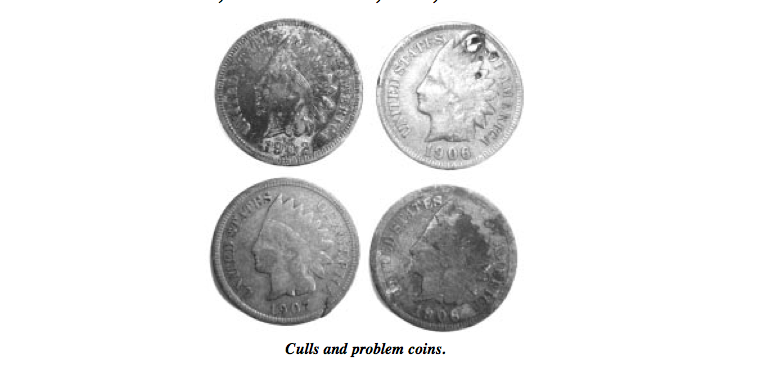
Given a random lot of unsearched low end Indian Cents, there are bound to be problem pieces which are unsalable,
These are called culls. They are worth something, but not to a self respecting collector. Dealers will usually
not pay anything for them, if they catch them. Corrosion, holes, rim cuts and other damage will destroy the
value of the coins. Do not buy these types of coins at any price.
Coins with even wear and no problems may be called AG for About Good, if the rims are worn into the field.
If the wear merges into the design then they may be called Poor. Valua- tions for these coins are subjective.
I would recommend buying only the very tough dates in this grade, and only if very cheap.
There is no price too cheap for a problem coin. Good: G-4, G-6, or G Heavy wear. Full rims on both sides. All letters in legend (USA) are readable.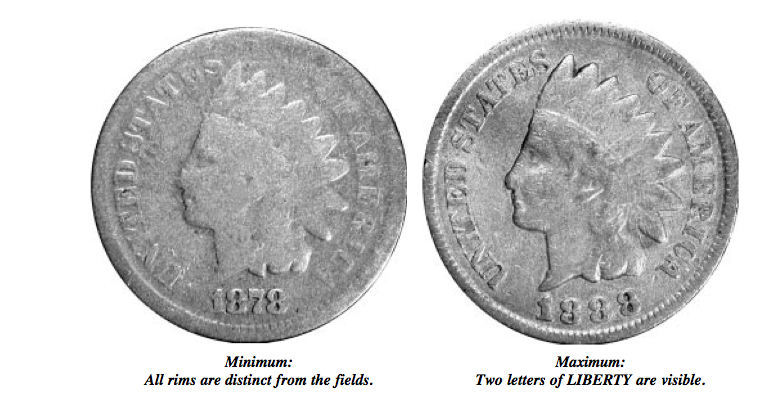
G-6 may be used to indicate exceptional pieces, say if many feathers show detail but few letters of LIBERTY are readable.
Typically the grade number is not used for average pieces.
Problem pieces should be discounted or avoided. Usually sellers tend to overlook problems at this grade level.
Buyers should realize this and closely inspect coins. Coins with smooth brown surfaces without rim nicks, scratches,
corrosion and dents are preferred.
The dividing line between G and VG coins is the detail in the LIBERTY. There is a slight difference between the two grades.
This also equates to a typically small difference in prices. If a significant price develops, determine if the G price is too low
or the VG price is too high.
Cheap coins are cheap for a reason.Coins in this grade are good entry-level coins for collectors desiring to fill holes in an album. If the coins are acquired
cheap enough, perhaps out of an old accumulation, then it can be a rewarding start.
If the coins are purchased individually, then the cost of upgrading may seem like a duplication of effort.
I would advise collectors to pay retail prices only for the tougher dates in this grade.
Many dealers will accumulate the common dates cheaply in collections they buy and will not be too interested in
buying singles in this grade except at a discount of 50% of retail.
Dealers actively search and pay closer to retail for the better dates in the late 1860’s and early 1870’s.
The 1877 in this grade is a very easy coin to sell, provided there are no problems with the coin. Dealers will therefore
pay strong prices. As prices have advanced for the 1877 in G and VG lately, it may be worthwhile buying a higher grade
for a 2X premium, if possible. The 1908-S and 1909-S is very difficult to find in this grade as most were taken out of circulation early.
Variety collectors usually don’t pay big dollar premiums for varieties in this grade, although the percentage premium can be quite high.
For example the 1897 S-1 “1 in neck” can be spotted easily in this grade and may sell for a 20X premium, but that would amount
to only $20. The 1873 Double LIBERTY can be authenticated in this grade by the doubling under the nose.
The shape of the bust point can be used to tell the design changes of 1864 apart.
The 1864 With L has a pointed bust, while the 1864 No L has a rounded bust.
Very Good: VG-8, or VG At least 3 letters of LIBERTY will show. 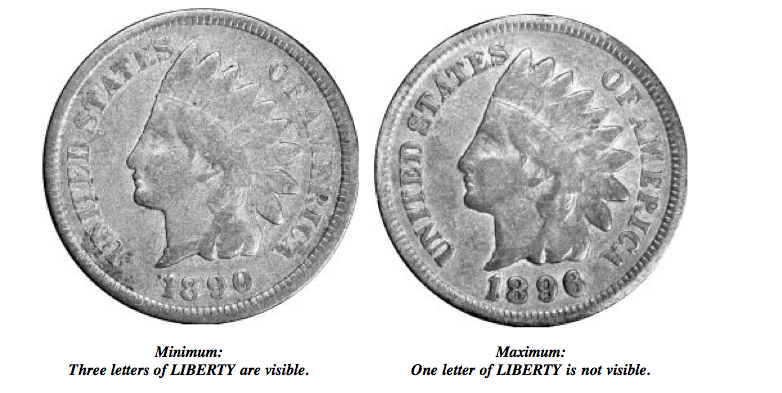
This is a very narrow grade range as it has been defined. The L & RT of LIBERTY are the typical letters that will show,
but any combination is acceptable. The letter may not be clearly defined. The grade number is usually not necessary
because there is no “Choice” VG. On the contrary, the grading range is so tight that Very Good should be considered
a “choice” qualifier for the Good grade.
Buyers may want to target VG over Good to bring up the look of their collection without additional expense in money.
However, the added expense would be terms of time.
Dealers will tend to group common date VG and G coins into the same pricing structure when buying. The values are
similar enough that this does little harm. Be wary if large price differences develop between G and VG.. This could be an
indication of a rising market. A premium of over 20% for VG would prompt me to buy the G and wait for the price to catch up to VG’s.
CN pieces are very difficult to find in VG due to the wear patterns of these coins. 1908-S and 1909-S are nearly unob-
tainable in this grade, which is why they are usually price similarly to Fine graded coins. Except to preserve uniformity,
buy the Fine grade in these dates.
For many better dates there is a big jump in price to the Fine grade. The collector demand of “Full LIBERTY” creates this jump.
A careful budget collector might be able to buy a coin that has enough detail to be worthy of a Fine grade, but because of its strike,
lacks some of the letters of LIBERTY. If coins like this can be bought for VG money, you’ve got a very good deal.
Conversely, if a big price difference is evident between VG and Fine, sellers will tend to take nice VG’s and grade them Fine.
These will be priced to look like bargains.
Grading does not change between dates.Collectors should attempt to keep the color of the coins uniform. An even chocolate brown is typically desired.
(Milk Chocolate, not Semi-Sweet). Avoid problem coins: weak strikes with rims merging into the rims but with some of LIBERTY
showing should not be graded VG. Cleaned coins should be downgraded to AG, not G. Bent, corroded and holed coins cannot
be sold and should be replaced.
Fine: F-12, F-15 or F All letters of LIBERTY will be at least partly visible.
The lower edge of the headband is indistinct.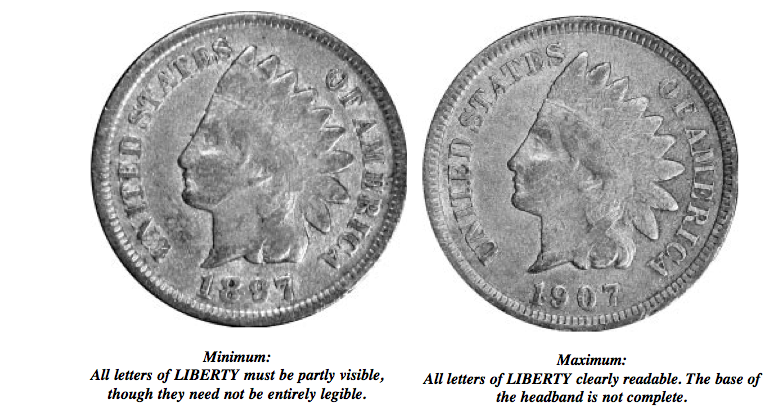
The grade range for Fine is very narrow, therefore F-15 is used only on very choice pieces that can not be called a higher grade.
A full VF with a weak strike or selective wear may qualify as a F-15.
This is the preferred minimum grade for many circulated set collectors. This is especially true for the tougher dates in the 1860’s
and 1870’s. Many collectors who otherwise target XF and AU will allow Fine graded coins for many of the expensive dates.
This added pressure makes these coins very easily for sellers to sell. Be wary of high end VG pieces offered as Fine at bargain prices.
Be even more wary if they are fully priced.
If the prices for Fine graded coins advance too close to VF money, then consider buying the higher grade.
1908-S and 1909-S may be occasionally found in this grade. This is the lowest recommended grade for these dates.
CN pieces in Fine should be priced 30% or more over the
VG price. If there is not that big a difference, it is due to added demand for these dates in any condition by Civil War memorabilia collectors.
Common dates are easily found in this grade. It is recommended that extra care be taken to find the best coin for the money for these dates.
This means balancing the cost with the condition of the coin. If VF prices remain closer to Fine than XF, I would recommend
always buying the VF over the Fine.
This is a good grade to look for varieties. Many dealers don’t have the patience to look closely at these coins in the more common dates.
Premiums for many varieties are much higher percentage than in higher, more expensive grades. The 1900-1909 dates alone hold many
varieties worth looking for. Here’s an area that even the collector with even the most modest budget can have years of fun and challenge.
My 1900-1909 Attribution Guide (Vol. 6) is a great source of information for this endeavor.
The 1873 Double LIBERTY Snow-1 is not highly desired in grades less than Fine. A Double LIBERTY where you can’t see the
LIBERTY is not highly desired.
The dividing line between Fine and VF is the lower headband. If it merges into the rim it is Fine, if it is complete it’s VF.
As with many single point grading criteria, there are excep- tions. An otherwise VF coin with a weak strike many properly be called Fine.
Very Fine: VF-20, VF-30 or VF, VF+ Moderate wear, Head band complete, lower hair curl joined to ribbon.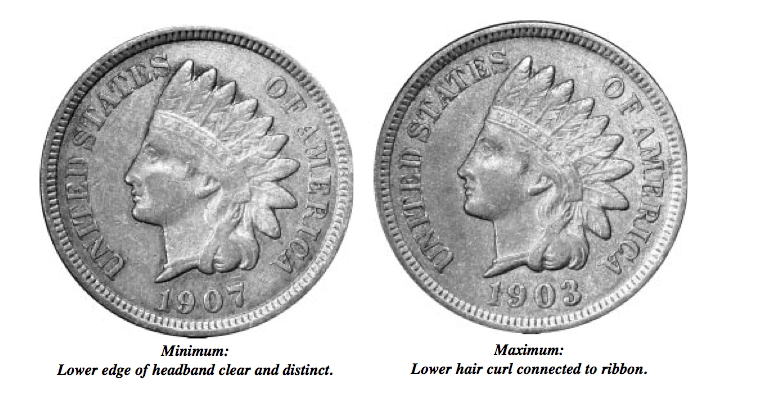
VF and XF are target grades for many collectors and are easily defined by the remaining detail on the coin.
A VF coin will have a full headband (or ribbon) by LIBERTY, but the ribbon end with the diamond detail
will be connected to the lower hair curl.
A basic XF coin will haver the lower hair curl clearly separated from the ribbon end.This is very clearly defined and easy to understand. It is a wonder that so many grading services get it wrong!
Never underestimate the other guy’s greed!It seems that most graders at the grading services use a flimsy standard called “market grading”. As I understand it, they
mold the grade of the coin to the market demand. If it is a choice VF with few marks they may give the coin an XF grade.
There are many VF coins in some of the tougher dates, like 1877, in certified holders graded AU! As a coin buyer, you must
take these differences into account when pricing a coin. Uses this guide as the ultimate test for a coins grade and apply it to
the price structure at the end of this guide.
For choice VF coins which may otherwise look like XF, but for some reason lack the defining detail, VF-30 can be used.
The dividing line between a typical VF (VF-20) and a choice VF (VF-30) is not so clearly defined. Some time is could be
the amount of marks, other times it could be the strike which determines wether a coin is typical or choice.
Many times a coin could have been struck weakly to begin with. This poorly made coin falls through the grades as it circulates
from AU-50 to VF-20 without ever being eligible to be assigned a grade in between! For example a coin with a weak strike
which mushes out the feather tips and lower ribbon may have AU luster but VF detail. Be very careful with paying too much
for these coins. Sure, buyer and seller may agree the surfaces qualify for a higher grade, but in the end it is better to buy a
coin with a solid strike and not have to worry about an additional grading question.
The quality is long remembered long after the price is forgottenPricing for VF’s should neve get too far behind the XF prices. If the price for a VF is less than 1/2 the XF price then one is either
too cheap or too expensive. Over time the market will correct these imbalances.
Extremely Fine: XF-40, XF-45 or XF, Light wear on the highest points. Ribbon and lower hair curl are separated. A trace of luster may show. 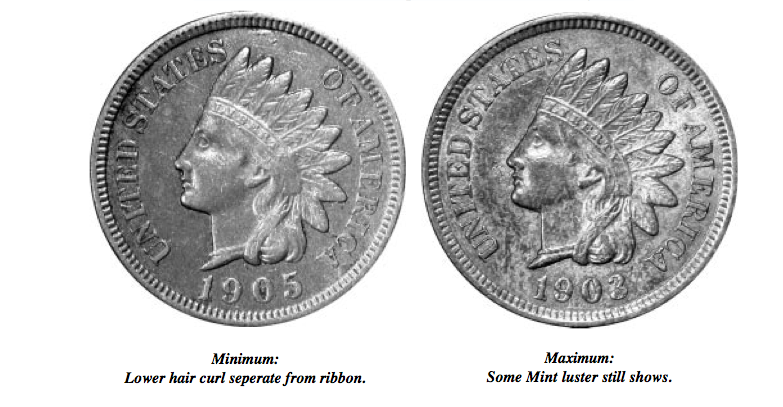
A typical XF (XF-40) will have good detail, complete lower ribbon, but the diamond detail will not be full. This may be cause of
strike or wear. If the missing diamond are due to strike then the feathertips may also be weak, and there may be some luster
present. If the missing diamonds are due to wear, then the feathertips may be somewhat full but the may be no luster.
There will, of course, always be some exceptions.
Choice XF (XF-45) will have full diamond detail.Many collectors desire well struck coins and target XF-45 for this reason. Any coin which fails this easy guide- line should be called
either XF-40 or AU-50.
All coins are have their destiny set the instant they are struck. If a coin is struck poorly, it starts out as a lower MS grade and will fall
down to AU-50 then to XF-40, VF-20, etc. without ever have the chance of being graded “choice” anything! Barring some unfortunate
mishandling, a well struck coin always has the benefit of gaining the “choice” qualifier.
Strike is independent of the grade, but not of the quality.Because of the higher demand for XF-45, there is a higher pricing structure for these coins over XF-40’s. These prices may not be
reflected properly in many pricing guides. Usually only XF-40 is given as a pricing column. The buyer of XF-45 coins should expect
to pay a 10% to $25 premium over XF-40 prices. On the other hand many happy buyers will find sellers mistakenly quoting XF-40
prices for XF-45 coins.
Be careful with problem pieces. Heavy corrosion typically lowers the value to that of a G or VG.. Many sellers will only slightly
discount these pieces, but in reality, they are drastically overcharging!
In determining the difference between an XF and AU, we turn from looking at detail loss to the amount of luster remaining on the coin.
Luster is not the same as color!Many collectors commonly confuse the luster of the coin with original red color on the coin. A typical XF coin will be a chocolate
brown color, either milk or semisweet. The luster is the original surfaces of the coin. On XF’s luster will typically be seen only in
the protected areas of the field. Setting a definite percentage of remaining luster as a dividing line between XF and AU is very difficult.
About Uncirculated: AU-50, AU53 or AU, AU+Some Mint luster will show. There will be a small trace of wear visible on the highest points of the coin.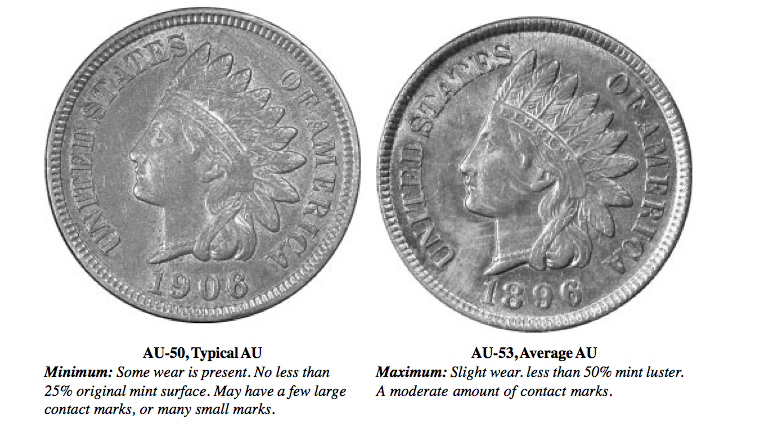
There are numerous reasons why a coin should be called a typical AU rather than some superlative. Perhaps it’s the number of marks.
Perhaps the coin was struck poorly to begin with. It may have been cleaned, have scratches or have rim problems.The amount of wear
will be minimal, so the detail on a well made coin will be nearly full.
What it does have is original surfaces - usually in the form of radial flowlines in the protected areas of the fields. We are not looking
for “Mint Red” to define the condition, rather we are looking at the “Mint Surface”. Even if a coin is chemically cleaned it will show
this Mint luster.
Luster is the original mint surface, not orginal color.The dividing line between XF and AU is based on the amount of wear and the amount of original surfaces. 25% of original surface
is given above, but this is a somewhat arbitrary amount. As with many aspects of grading Mint State coins, the look is an important,
yet nonquantifiable factor in evaluating the grade. If a coin has some noticeable cartwheel effect it probably qualifies for AU.
If the surfaces look flat andworn,it probably should grade XF.
Depending on the die state, the original surfaces of an AU coin can be described as anything from proof-like to having cartwheel
luster to a very late die state. A very late die state coin with mushy design elements should be graded no higher than AU-55
If an otherwise AU coin is poorly struck with missing design elements then it should be graded AU-50 with a qualifier in the description.
If there is any original red color remaining, then a RB (Red-brown) qualifier may be added. Cleaned AU coins should be graded no
higher than AU-50 with the cleaning described.
Choice About Uncirculated AU-55, AU58 Considerable Mint luster will show. There will be a small trace of wear visible on the highest points of the coin.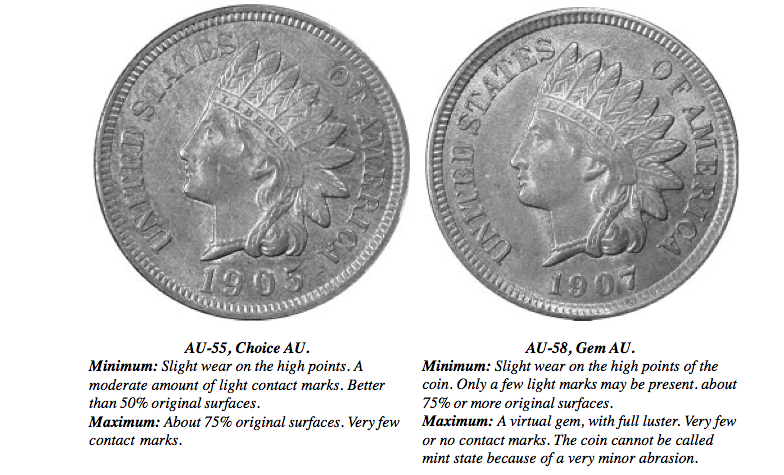
A choice AU coin should have a better than average strike, fewer than average marks, and better than average eye appeal.
The dividing line is not well defined, so there is much to be interpreted.
The amount of original surface intact is an inexact measure and should be used as a loose guide. The original surface can be
called the cartwheel luster, keeping in mind that very early die state pieces may not have a cartwheel effect.
Coins with original red color may be designated with a RB (red-brown) designation.
Coins which are cleaned may not qualify for AU-55 or AU-58. Minor problems only are acceptable for these grades.
Coins with striking problems or struck from very late dies may not be graded higher than AU-55.
An AU-58 coin is visually more appealing than a MS60.An AU-58 coin may appear to be Mint State (MS-63 or higher) but is limited by slight luster breaks on the highest points.
To find luster breaks, tilt the coin in the light so that slight differences in the reflection can be seen. These differences in the
texture of the surface are an indication of wear on the coin. Differences in color, browning on the high points, for example,
are not clear indications of wear.
With overgrading rampant, coins in this grade typically get MS grades even though wear is apparent. This is called “Market Grading”.
Market grading basically grades a superior looking coin to a grade level appropriate with the coins value based on its look,
not actual grade. One would think that a coin with any wear should not get graded MS, but this is not the case. Regardless,
the standards set here are deemed necessary to communicate the actual grade of the coin, not its market value. As such, properly
graded AU- 58 coins will sell for MS-61 or MS-62 money.
Typical Mint State: MS-60 to MS-61 No trace of wear. Obvious blemishes, such as contact marks, small spots or unnatural color are present 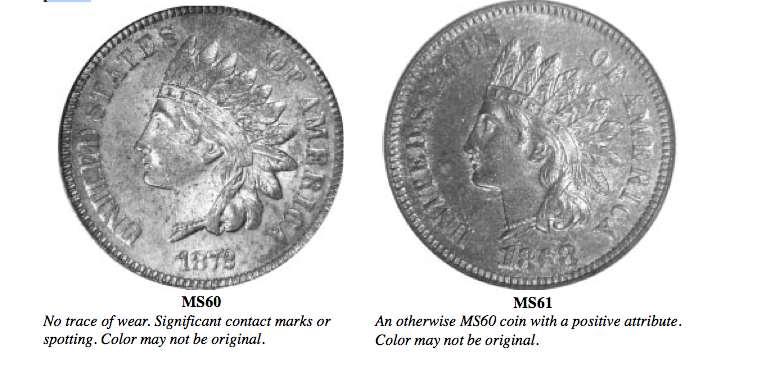
Of the Mint State grades, MS60 is at the lowest end of the grading spectrum. It is uncirculated, but is not deserving of any
greater quality qualifier. MS60 is possibly the most misunderstood grade. Most pricing guides list coins in this grade, but in that
context, MS60 can be thought of as a generic label, similar to “Unc” or “BU”. In practice, the grade is not particularly desirable,
as no seller wants their coin to be the lowest graded MS example.
The reason coins will be downgraded to MS60 may be significant contact marks from other coins prior to being placed in circulation.
However, there should be no evidence of wear. This definition makes slightly worn coins without marks (AU58) more desirable in
many collectors eye’s than MS60.
Is it better to have a low end MS coin or a high end AU coin?Any physical movement of the surface metal will cancel any chance of a MS grade. These coins include wizzed coins which have
the surfaces wire brushed to simulate Mint luster.
Coins that at one time were a higher grade but have acquired unattractive carbon spotting or staining may fall down to the MS60 grade.
The problem should be obvious without the aid of a magnifying glass.
The color of MS60 can be original, but it is possible the coin was chemically cleaned or retoned to an unnatural color and still qualify for
MS60. If Mint luster still shows, even though the color is wrong, it is still considered Mint State. If the luster is diminished by the cleaning
then no wear should be detectable.
The MS61 grade may be assigned to coins that may be defined as MS60 but have better than average eye appeal. It could also be a coin
which would grade higher were it not for a problem (cleaning, spots, hits) which lowers its eye appeal considerably. This grade is highly
subjective, and is rarely used.
Typical Mint State:MS-62 to MS-63 Minor blemishes such as contact marks, small spots or unnatural color are present. Acceptable eye appeal.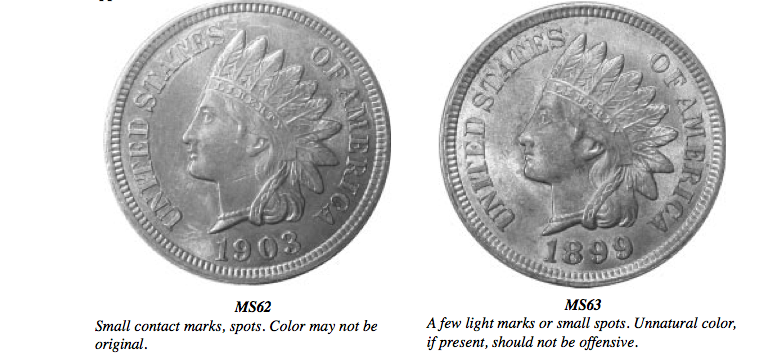
MS62 is assigned to coins which just miss qualify- ing for MS63 by some obvious problem. These may have good eye appeal except
for the grade limiting problem.
Coins that are otherwise higher grades may be down graded to MS62 due to unnatural color if the surfaces are still acceptable for a MS coin.
For example a chemically cleaned coin may still have its original luster, but not original color.
The MS63 grade is one of the most popular grades for collectors of uncertified Indian Cents. It is generally accepted that otherwise
attractive coins of a higher grade which do not have original color can receive this grade. With rare exceptions, this is the highest grade
a cleaned coin can grade. Mostly coins which has been once cleaned and subsequently expertly retoned may qualify as acceptable
in this grade. Any cleaned coins should be mentioned as such.
For original coins, this grade is defined as “Typical:” or “Average”. Coins should have marks or spots which are not overtly offensive
to the eye appeal of the coin. There should be no marks which one would consider being “heavy”. Neither should there be any spots
considered “large”.
A coin which is otherwise a higher grade, but exhibits a substantially weak strike or a large debris strike- through may be given the
MS63 grade. A debris strike- through is caused when a substance, such as machine oil drips onto the planchets and is impressed
into the coin when the coin is struck.
Color designationsBronze Mint State Indian Cents usually are desig- nated with a color designation BN for Brown, RB for Red- Brown and RD for Red.
The color qualifier follows the grade number, for example: MS63RB.
Most coins in MS63 or lower are found with RB or BN designations. MS63RD coins do exist, but beware of cleaned examples sold
as red without mention of the cleaning.
Red-Brown coins can vary from nearly brown to nearly full red. The percentage of red can be listed if it effects the value of the coin.
RB coins very close to BN or RD colors may get those designations depending on the overall look of the coin. For example, a very
attractive coin with RD color and a slight toning around the edge from being held in a cardboard album for many years may still be
properly graded with the RD designation.
It is implied by higher prices that a RD coin is worth more than a RB and both are worth more than a BN coin. It is up to the individual
collector to determine, using their own tastes, what should be included in a collection. Certainly a well matched BN collection is as
impressive as one with varying shades of RB and RD coins.
Aside from color and technical grade, consider other aspects of a coin such as strike and die state. These are currently not quantified,
but well struck early die state pieces add significantly to the aesthetic appeal of a coin. These issues will be discussed under the higher grades.
Gem Mint State: MS-64 to MS-65 No trace of wear. Obvious blemishes, such as contact marks, small spots or unnatural color are present.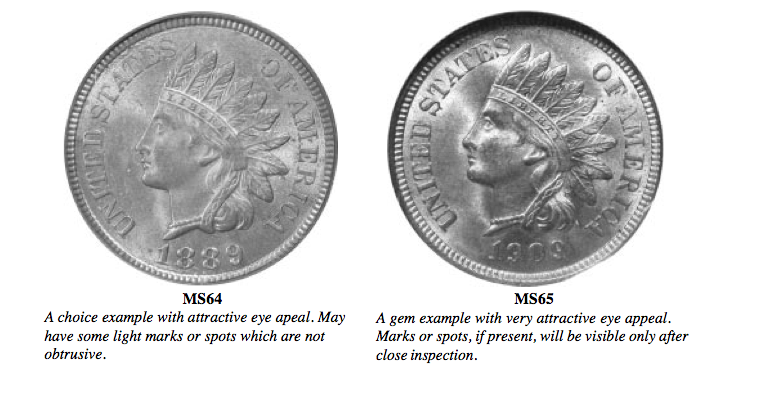
MS64 is classically defined as a “Choice” coin. Given a random group of uncirculated coins, a MS64 is the average grade of the top coins
chosen for eye appeal. This is very general, and in truth there is no precise way to specifically delineate what coins deserve this grade.
They should not be ugly, for sure. How many impairments are acceptable? Just enough to keep the eye appeal attractive. Large spots
are not acceptable, but scattered small spots may be acceptable. Many collectors do not like spots. The presence or lack of small
spots may be more of a personal requirement than a grading criterion. Contact marks are usually less offensive.
Their placement and severity should be judged subjectively.
On MS64 and higher grades the surfaces should be unimpaired, and natural. Aggressively cleaned and obviously chemical cleaned
coins should not be graded MS64 or higher.
The strike of a MS64 coin should not be unusually weak. Any weakness should be described. Since the striking quality is a Mint made
factor, it is independent of the condition. Certianly collectors should seek out well struck coins. Weakness will usually show up on the
first three feather tips and the diamond area of the lower hair curl.
MS65 is classically defined as a gem coin. Careful search of a large group of random uncirculated coins may reveal a gem, or maybe not.
These are very eye appealing and will have no major impairment. While not perfect, a MS65 may look perfect until a close inspection
reveals some flaw. Small spots may be present, and may be a personal reason for regection. Contact marks, if present will be
minimal and not obvious.
The strike should not be a negative factor. In other words it should have a fairly good to full strike.
Color and grade are not directly related. Color and price are directly related.An added color designation is required for bronze issues from 1864 onward. BN and RB for Brown and Red-Brown (discussed under MS63)
and RD for coins with full Mint Red color. Original RD color is the color of the coin as it was originally struck. It is a very delicate surface and
any foreign substance on the surface: saliva, finger oil or chemicals (sulphur mostly) in humid conditions will act on it and change it to RB.
Original RD coins will generally continue to maintain their color if they have lasted full RD for the last 100 years. Coins which have been
improperly cared for or “Improved” may not remain full red. Careful inspection of coins presented is important.
Gem Mint State:MS-66 to MS-67 Minor blemishes such as contact marks, small spots or unnatural color are present. Acceptable eye appeal.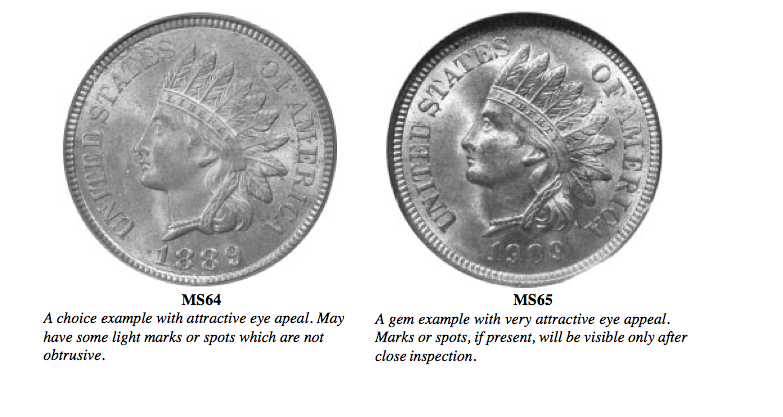
MS66 coins should be visually spectacular. The luster should be outstanding and there should be a minimal of marks. Defining the
distinction between MS65 and higher grades is based more on subjective factors than lower grades. The eye appeal factor (WOW factor)
plays a huge role in determining a MS66 over a MS65. There should be very few marks, and those present should be very minor.
No spots should be visible, except under high magnification.
The strike should be full, or very nearly so. Color must be original. Certified grading by a top tier grading service for coins in this grade
is highly recommended.
The bronze issues must carry a color designation, BN for Brown, RB for Red-brown, and RD for full red. Brown coins should not be
dull or washed out in appearance. Red-Brown coins should also have exceptional luster with attractive coloration patterns. Full red coins
should have no toning, expect perhaps near the rims. All should be highly lustrous and well struck.
Debris strike-throughs should be limited to small unobtrusive artifacts. Nicks should be very minor and likewise, unobtrusive.
This is essentially the ultimate grade available. NGC and PCGS each report close to 100 examples graded for the entire series.
These 200 or so pieces are mostly bunched up in the later dates 1898-1909. When any become available they are scrutinized for every
little defect and valued accordingly. Since grading services do not give out this grade lightly, there is great demand for these when they appear.